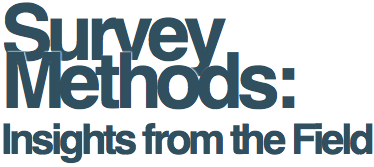Archive for "December 2020"
Measuring sexual behaviours and attitudes in hard-to-reach groups. A comparison of a non-probability web survey with a national probability sample survey
Introduction: Hard-to-reach and minority groups are often at higher risk for adverse sexual health outcomes. While such groups are therefore of interest to sexual health researchers, it can be difficult to locate and recruit sufficient sample sizes using probability sampling methods. This study aims to establish whether web-panel surveys can provide a viable less resource intensive means of boosting sample sizes of two hard-to-reach groups (people of Black African ethnicity, and gay men) for a sexual health survey, and the extent of any bias. Methods: Results from a national probability sample survey (Natsal-3, administered using a computer-assisted personal interview (CAPI) …
Does name order still matter for candidates in a presidential primary poll in the US? Lack of response order effect in a web survey experiment
During elections, political polls provide critical data for the support each candidate receives. For that reason, the measurement of questions asking about candidate support has been receiving some research attention. As the online survey is increasingly becoming a widely used tool for public opinion and election polls, evaluation of the measurement error associated with this survey mode is of importance. This study examines whether a candidate name order effect exists in presidential primary election surveys in the US. The findings show that contrary to previous studies the order of names does not have a significant impact on the support candidates …
Does the Choice of Header Images influence Responses? Findings from a Web Survey on Students’ Housing Situation
Online questionnaires can easily be complemented by logos, graphics and images. Yet visual cues can influence responses – adding images to survey questions has proven to alter reported frequencies and attitudinal judgments. Our experiment, which was embedded in a web survey on students’ housing conditions (N=4,676), addresses the effects of continuous exposure to a content-related image. Participants saw one of three different residential scenarios or no image, respectively, in the header of each page throughout the whole survey. It is expected that different pictures influence self-rated satisfaction with the current housing situation and the evaluation of city attributes. Contrary to …
Research Note: Reducing the Threat of Sensitive Questions in Online Surveys?
We explore the effect of offering an open-ended comment field in a Web survey to reduce the threat of sensitive questions. Two experiments were field in a probability-based Web panel in the Netherlands. For a set of 10 items on attitudes to immigrants, a random half were offered the opportunity to explain or clarify their responses, with the hypothesis being that doing so would reduce the need to choose socially desirable answers, resulting in higher levels of prejudice. Across two experiments, we find significant effects contrary to our hypothesis – the opportunity to comment decreased the level of prejudice reported, …





